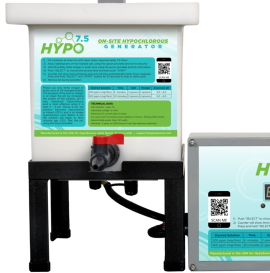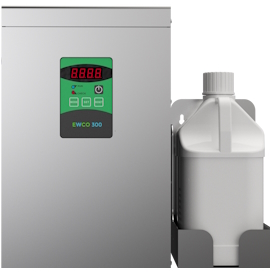Исследование > Микроб > Fungi > Penicillium
Часто используемые названия для растворов хлорноватистой кислоты
- Electrolytically Generated Hypochlorous Acid
- Neutral Electrolyzed Water (NEW)
- Electrolyzed Oxidizing Water (EOW)
- Electro-chemically Activated Water (ECA)
- Super-oxidized water (SOW)
Результаты: 4 опубликованные статьи

Microbe(s): Penicillium digitatum, Pseudomonas spp.
The efficacy of thin-film diamond coated electrodes (DiaCell 101) for disinfection of water artificially contaminated with Penicillium digitatum and Pseudomonas spp. was tested. Electrolysis process was performed with different operation conditions: current densities at 4, 8, and 12A and water flow rate at 150, 300, and 600 L/h. For both pathogens, the experiments were performed in water suspensions at a final concentration of 105 CFU/ml. Tap water was used as a control. The results showed that fungal spores and bacterial cells were affected by flow rate and current density applied. The higher the water flow rate the greater the inactivation of the two microorganisms which were completely suppressed at high recirculation flow (300-600 L/h/cell). Pseudomonas spp. cells were inactivated at the highest current density applied (8-12A) after 6 min of electrolysis, whereas for P. digitatum the complete inactivation was observed at the same current densities after 12 min. The results obtained suggest that the two parameters can be modulated in order to achieve significant suppression in relation to the target microorganism and to obtain an antimicrobial effect without generation of chlorine.

Microbe(s): Fungi, Penicillium digitatum
The effect of electrolyzed oxidizing (EO) water in combination with ozone to control postharvest decay of tangerine was investigated. The spore suspension containing 105 conidia ml 1 of Penicillium digitatum was prepared. EO water was generated by electrolysis of various concentrations of NaCl solution (5, 25, 50% and saturated NaCl). The spore suspension was inoculated into EO water and incubated at 27 C for 1, 2, 4, 8 and 32 min. It was found that the EO water with saturated NaCl completely inhibited the spore germination of the fungus within 1 min. When the fruits inoculated with P. digitatum were washed in EO water at the same concentrations as previous experiment for 4, 8 and 16 min and stored at 5 C for 18 days, it was found that immersion of the fruit in EO water for 8 min was the most effective to reduce disease incidences. Moreover, washing fruit in EO water and kept in a refrigerated chamber at 5 C with continuous ozone exposure at a concentration of 200 mg l 1 for 2 h day 1 to extend storage life suppressed the disease incidence until 28 days. However, none of the treatments had any effect on the quality of fruit such as total soluble solids, titratable acidity, percent weight loss and peel color. Therefore EO water may be useful for surface sanitation and ozone has potential to control the recontamination of postharvest diseases in tangerine fruit in storage room.

Microbe(s): Fungi, Penicillium expansum
The use of water flotation tanks during apple packing increases the risk of contamination of apples by spores of Penicillium expansum, which may accumulate in the recirculating water. Routine addition of sanitizers to the water may prevent such contamination. Sodium hypochlorite (NaOCl), chlorine dioxide (ClO2), and electrolyzed oxidizing (EO) water have varied activity against spores of P. expansum, and their effectiveness could be enhanced using surfactants. The objective of this study was to determine the ability of three nonionic surfactants, polyoxyethylene sorbitan monooleate (Tween 80), polyoxyethylene sorbitan monolaurate (Tween 20), and sorbitan monolaurate (Span 20), to enhance the efficacy of NaOCl, ClO2, and EO water against spores of P. expansum in aqueous suspension at various temperatures and pH conditions. The efficacy of NaOCl solutions was enhanced by the addition of surfactants at both pH 6.3 and pH 8 (up to 5 log CFU reduction). EO water and ClO2 were effective against P. expansum spores (up to 5 log CFU and 4 log CFU reduction, respectively), but addition of surfactants was not beneficial. All solutions were less effective at 4 C compared to 24 C irrespective of the presence of surfactants. Nonionic surfactants could potentially be used with NaOCl to improve control of P. expansum in flotation tanks, but the efficacy of such formulations should be validated under apple packing conditions.

Microbe(s): Fungi, Penicillium expansum
Spores of Penicillium expansum, the primary organism responsible for the occurrence of patulin in apple juice, were exposed to electrolyzed oxidizing (EO) water in an aqueous suspension and on wounded apples. Full-strength and 50% EO water decreased viable spore populations by greater than 4 and 2 log units, respectively. Although EO water did not prevent lesion formation on fruit previously inoculated with P. expansum, cross-contamination of wounded apples from decayed fruit or by direct addition of spores to a simulated dump tank was substantially reduced. EO water, therefore, has potential as an alternative to chlorine disinfectants for controlling infection of apples by P. expansum during handling and processing operations.
Best Hypochlorous Acid (HOCL) Generators
 Portable Hypochlorous Acid (HOCL) Machine
Portable Hypochlorous Acid (HOCL) Machine
Make high quality hypochlorous acid in the home or office.
$159.99 + Free Shipping
 HOCL Machine + Electrostatic Sprayer
HOCL Machine + Electrostatic Sprayer
Make hypochlorous acid and spray with an electrostatic cold fogger.
$309.98 + Free Shipping


